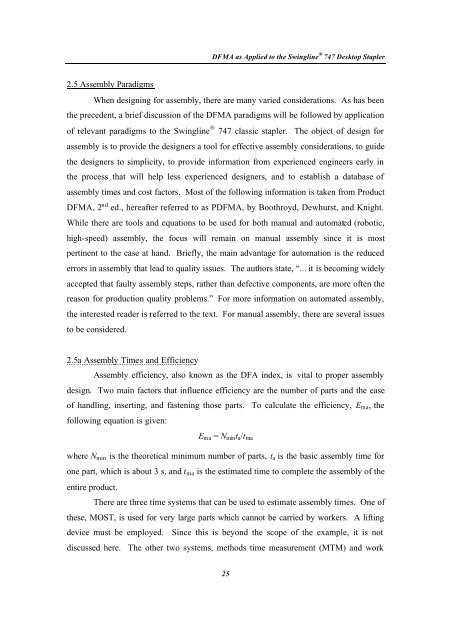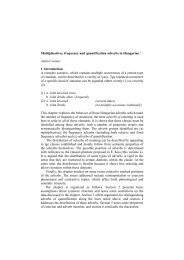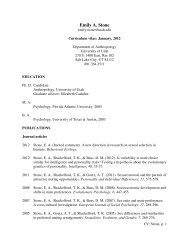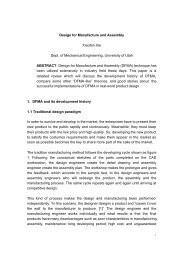DFMA as Applied to the Swingline 747 Desktop ... - University of Utah
DFMA as Applied to the Swingline 747 Desktop ... - University of Utah
DFMA as Applied to the Swingline 747 Desktop ... - University of Utah
You also want an ePaper? Increase the reach of your titles
YUMPU automatically turns print PDFs into web optimized ePapers that Google loves.
2.5 Assembly Paradigms<br />
<strong>DFMA</strong> <strong>as</strong> <strong>Applied</strong> <strong>to</strong> <strong>the</strong> <strong>Swingline</strong> ® <strong>747</strong> Desk<strong>to</strong>p Stapler<br />
When designing for <strong>as</strong>sembly, <strong>the</strong>re are many varied considerations. As h<strong>as</strong> been<br />
<strong>the</strong> precedent, a brief discussion <strong>of</strong> <strong>the</strong> <strong>DFMA</strong> paradigms will be followed by application<br />
<strong>of</strong> relevant paradigms <strong>to</strong> <strong>the</strong> <strong>Swingline</strong> ® <strong>747</strong> cl<strong>as</strong>sic stapler. The object <strong>of</strong> design for<br />
<strong>as</strong>sembly is <strong>to</strong> provide <strong>the</strong> designers a <strong>to</strong>ol for effective <strong>as</strong>sembly considerations, <strong>to</strong> guide<br />
<strong>the</strong> designers <strong>to</strong> simplicity, <strong>to</strong> provide information from experienced engineers early in<br />
<strong>the</strong> process that will help less experienced designers, and <strong>to</strong> establish a datab<strong>as</strong>e <strong>of</strong><br />
<strong>as</strong>sembly times and cost fac<strong>to</strong>rs. Most <strong>of</strong> <strong>the</strong> following information is taken from Product<br />
<strong>DFMA</strong>, 2 nd ed., hereafter referred <strong>to</strong> <strong>as</strong> P<strong>DFMA</strong>, by Boothroyd, Dewhurst, and Knight.<br />
While <strong>the</strong>re are <strong>to</strong>ols and equations <strong>to</strong> be used for both manual and au<strong>to</strong>mated (robotic,<br />
high-speed) <strong>as</strong>sembly, <strong>the</strong> focus will remain on manual <strong>as</strong>sembly since it is most<br />
pertinent <strong>to</strong> <strong>the</strong> c<strong>as</strong>e at hand. Briefly, <strong>the</strong> main advantage for au<strong>to</strong>mation is <strong>the</strong> reduced<br />
errors in <strong>as</strong>sembly that lead <strong>to</strong> quality issues. The authors state, “…it is becoming widely<br />
accepted that faulty <strong>as</strong>sembly steps, ra<strong>the</strong>r than defective components, are more <strong>of</strong>ten <strong>the</strong><br />
re<strong>as</strong>on for production quality problems.” For more information on au<strong>to</strong>mated <strong>as</strong>sembly,<br />
<strong>the</strong> interested reader is referred <strong>to</strong> <strong>the</strong> text. For manual <strong>as</strong>sembly, <strong>the</strong>re are several issues<br />
<strong>to</strong> be considered.<br />
2.5a Assembly Times and Efficiency<br />
Assembly efficiency, also known <strong>as</strong> <strong>the</strong> DFA index, is vital <strong>to</strong> proper <strong>as</strong>sembly<br />
design. Two main fac<strong>to</strong>rs that influence efficiency are <strong>the</strong> number <strong>of</strong> parts and <strong>the</strong> e<strong>as</strong>e<br />
<strong>of</strong> handling, inserting, and f<strong>as</strong>tening those parts. To calculate <strong>the</strong> efficiency, Ema, <strong>the</strong><br />
following equation is given:<br />
Ema = Nminta/tma<br />
where Nmin is <strong>the</strong> <strong>the</strong>oretical minimum number <strong>of</strong> parts, ta is <strong>the</strong> b<strong>as</strong>ic <strong>as</strong>sembly time for<br />
one part, which is about 3 s, and tma is <strong>the</strong> estimated time <strong>to</strong> complete <strong>the</strong> <strong>as</strong>sembly <strong>of</strong> <strong>the</strong><br />
entire product.<br />
There are three time systems that can be used <strong>to</strong> estimate <strong>as</strong>sembly times. One <strong>of</strong><br />
<strong>the</strong>se, MOST, is used for very large parts which cannot be carried by workers. A lifting<br />
device must be employed. Since this is beyond <strong>the</strong> scope <strong>of</strong> <strong>the</strong> example, it is not<br />
discussed here. The o<strong>the</strong>r two systems, methods time me<strong>as</strong>urement (MTM) and work<br />
25





